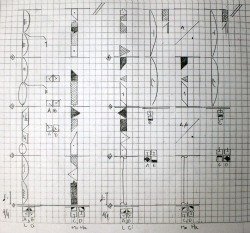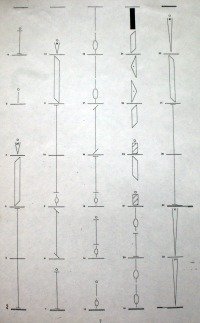| Back to Back Issues Page | |||||||
 |
|||||||
|
USE OF SIMPLIFIED LABANOTATION, The Dance Thinker, Issue #4. February 24, 2011 |
|||||||
The Dance Thinker Issue # 4, Feb 24, 2011
1. PLEASE READ THIS: If you have had trouble following links or viewing images from our e-zine, it might be a situation caused by your browser (Internet Explorer, Firefox, Safari, etc.) I’m very sorry for this bother, but it is absolutely out of my control. The solution to this: visit our e-zine archive, which you will find in the right column on every page at contemporary-dance.org. Its link says: The Dance Thinker BACK ISSUES. From there, you’ll always have access to all of the articles, with complete display of images and fully working links.
Articles 1. Advantages of the use of simplified Labanotation (Motif Writing).
- A page for contemporary dance announcements in which you can post your news about workshops, auditions, performances, meetings or any current, related items. - A contemporary dance blog that will automatically distribute what you post to facebook, twitter and all subscribers to the site’s RSS feed. - A worldwide, contemporary dance directory of schools, companies and websites to which you can submit your contact information. - Several pages in which you can participate with contributions, questions, ratings or comments. - An archive for THE DANCE THINKER back issues, where you can always revisit precedent articles. - A contact form through which you can address to me directly if you have questions, ideas, wishes, suggestions or commentaries. 2. It is easy to subscribe to The Dance Thinker. If you know somebody that would profit from receiving our e-zine, just let her/him know about the small subscription form at the right column on every page in the site.
Articles 1. Advantages of the use of simplified Labanotation (Motif Writing). Summary: 1. Efficiency of rehearsing time. 2. Social recognition. 3. Choreographic consciousness.
Ever since I started studying Rudolph Laban’s system for analyzing and writing movement, I’ve had colleagues around me asking: ¿but… what is it good for? It always struck me to realize that I never doubted about the interest of such a tool, while many dancers didn’t see its possibilities. Though, I understand now that my perspective was highly determined by my own educational history, in which knowledge was always legitimated by written supports (both for the verbal and musical languages I learnt). Then, during the time I was specializing my self in Labanotation studies, I confirmed that the use of Laban’s system would allow a transformation of the dancer’s movement, as much as of her/his body and consciousness. I also verified that it really is enough and effective to write dance to the most tiny detail, if desired. Though, it was clear to me that such practices needed a lot of dedication, which in many social contexts (particularly mine, in Colombia) would not currently be available. So, my conclusion after various years of studies was that for practical and mainly economical reasons, detailed analyzing and writing of dance could be seen nowadays as useful, only in highly developed dance contexts (which still are just a few around the world).
However, I continued using the basics of Laban’s kynetography in a dance composition course I currently teach. The lack of time, and the need of easy and practical issues, made me decide to follow the simplified application developed by Valery Preston Dunlop in her series of books “Readers in Kinetography Laban. Motif writing for dance.” (from MacDonald & Evans,1967), together with the French version “La symbolisation du mouvement” from Jacqueline Challet Haas (edited by the C.N.E.M, 2001). In this kind of simplified Labanotation, the score written is more like a general outline. Dance is described in broad strokes, but complete enough to remember its basic features (like rhythmic structure, paths in space, turns, jumps or main gestures). After four continuous terms teaching this course, I can say that even in underdeveloped dance contexts, simplified Labanotation can be very useful. 1. EFFICIENCY of rehearsing time. I’ve seen completely inexperienced students composing solos and group choreographies efficiently (almost to bet that better than without using the system). They also have the possibility of studying their dancing roles on their own, before arriving to rehearsals, and anybody from a group can rehears another one’s choreography to her/his dancers. 2. SOCIAL RECOGNITION. Laban knew this, and still, almost one century after him, dance continues to be considered by society and institutions as a minor art. In the dance composition course I teach, we usually invite musicians to accompany our choreographies after we’ve already finished composing them (we create without music). You’d be amazed to see the difference of attitude those musicians have towards us, after they discover that we use dance scores. Personally, I don’t believe that dance needs to have its written language to grow, become more refined or sophisticated. That process has happened in dance despite the oral and gestural transmission. But society has remained blind to all this development, and yet, in the era of the ‘modern, literate civilization’, non written languages (like dance) stand as minor and insubstantial. Heck… We would not do the work of writing everything down, just for others to understand there’s something elaborated behind what we do… But, if society realized that dance can be as sublime as any other form of art or science, can you imagine how many institutional and social changes we could achieve?
3. CHOREOGRAPHIC CONSCIOUSNESS. Now this one is the REAL REAL advantage and usefulness of Labanotation, whether simplified or not (at least for what concerns knowledge and art). People always say to me: …¿but why to bother writing if you can make a video of it? All experienced dance writers know it: to write, you need to analyze and by analyzing you tremendously increase your consciousness of the dance you are studying. This can help the dancer understand the details of a specific technique; the choreographer can work in advance without the need of the dancers; the researcher can have a frame to understand the differences between choreographic styles; the teacher can speed some of the learning processes; the dance community can construct a choreographic culture based on the knowledge provided by the written language… Yet I understand that Laban’s system is just one way of proceeding towards all this needs from our practice. Still I ask my self: Does the degree of choreographic consciousness really matters? If it does, is this the kind of consciousness we want to have? Or, which is it? What is the type of relationship we want to keep towards our choreographic production? Maybe those are questions that will be answered now, by each choreographer, in her/his creative intimacy. But, concerning the global development of dance, I’d like to remember something I wrote in another article about Labanotation: “… To those who are still asking themselves what the use of kynetography might be, I’d say you could ask yourselves what written language and its evolution means for humanity today. I bet Cro-Magnons didn’t imagine the reality in which we live nowadays". Remember to feel free to answer this e-mail. Let me know what you think. I’m always opened to suggestions, ideas, wishes…
Editor and Webmaster of contemporary-dance.org
|
|||||||
| Back to Back Issues Page |

